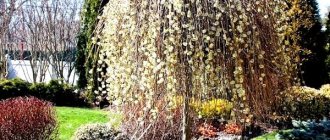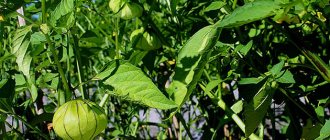The genus of willow or willow (Salix) is extremely numerous and difficult to classify. Its species easily cross-pollinate with each other, creating numerous hybrids that are often difficult to identify.
About 400 representatives of the genus are known, of which only a few are widely used in landscape gardening.
In addition to being unpretentious and easy to care for, decorative willow is represented by dozens of picturesque varieties - trees and shrubs that, after planting, fit into any garden design; most of them do not lose their attractiveness for many years.
Arctic willow (Salix polaris)
Another low-growing shrub from the Willow family, polar willow, is ideal for rock gardens and rock gardens.
It grows in a small curtain, clinging to the ground. This is a low-growing plant with dark green shiny leaves that do not fall off in the fall, but are hidden from the cold in the snow. In nature, polar willow, as the name implies, grows in the far north, in the tundra, being good food for deer. And local residents brew tea from its fragrant leaves.
This creeping shrub is well adapted to growing on poor rocky soils, is unpretentious and easily propagated vegetatively. In addition, it allows you to securely secure stone substrates that tend to crumble.
Decoration of a summer cottage goat willow
Goat willow, otherwise botanists call it Bredina (Selix carrea), and in common people it is simply Rakita, a plant belonging to the Willow family.
Europe is considered its homeland, but it grows successfully in Western Asia, the Caucasus and Central Asia. The average life expectancy is 150 years. During this time, the height of the plant can reach 10 m and 0.75 m in trunk diameter. Many gardeners wonder whether goat willow is a tree or a shrub? Everyone calls it differently, but in general classification it is a deciduous tree, sometimes a tree-like shrub. Based on the name, we can conclude that sheep and goats like to feast on the plant.
Use in landscape design
Matsudana willow adds luxury and sophistication to the garden in which it grows. The culture goes well with almost all types of conifers, deciduous trees and shrubs. It is planted both in compositions with other crops and solo, and they decorate reservoirs with it. Such a willow will fit perfectly into any flower garden. But it, of course, has a special and central place in a Japanese-style garden. The twisting willow with its entire appearance instills relaxation and tranquility.
There is not a single owner of this plant who would regret their purchase. Willow is easy to care for and will effectively complement an existing landscape design or be an excellent starting point for creating a new garden style. Matsuda willow can also be used as a hedge. In addition, in nature there are no two identical Chinese willows, so each site with such a planting automatically becomes unique. Due to the fact that the crown can be easily adjusted, it can easily be formed into various shapes: a ball, a pyramid or a cylinder. Everything is limited only by the gardener’s imagination. And Matsuda willows can be planted in an entire alley.
For more information about the features of Matsudana willows, see the following video.
Beauty and form
Goat willow in landscape design (photo can be seen below) is very common. And all thanks to its beauty and shape. Moreover, the appearance of the plant greatly depends on the soil in which it grows and the light level.
Most often, broom is planted when landscaping private houses and estates. At first glance, the willow seems unprepossessing, but thanks to its weeping forms, grafted onto the trunk, it acquires a very attractive appearance.
Willow also looks great in rocky gardens, as well as on the edge of ponds. It is worth appreciating another advantage of the plant - the ability to hold the soil together with its roots, so it is not surprising that it is often planted on slopes.
Description
Looking at this variety of willow, one cannot help but note that it has Japanese roots, despite the fact that it can often be found in areas with a temperate climate. Distinctive characteristics allow this shrub to become one of the favorites among gardeners from different parts of the world. As for the description, "Hakuro Nishiki" grows to a maximum height of 3 meters. For the Willow family this is not much, since the average height of the trees is approximately 5-6 meters.
The older the tree, the more its shoots bend, due to which even plants that have not been pruned in a timely manner acquire a rounded shape.
The leaves of the tree are spotted and have rather delicate shades. There are beige-green, light green and even pinkish colors mixed here, which change depending on the time of year. The more the temperature drops, the more saturated the color the leaves acquire, and the contrast, on the contrary, decreases. This characteristic makes the bush very attractive for landscape design, which gardeners successfully use when designing their plots.
"Hakuro Nishiki" is a flowering tree. In spring, buds of yellow-green to purple hue appear on it. The bark has a grayish color, and branches with a brown tint look much brighter against its background.
Willow feels great on the banks of reservoirs. Thanks to its branched root system, it is even able to withstand their collapse, promoting natural strengthening. At the same time, one cannot fail to note the frost resistance of the tree. The variegated “Hakuro Nishiki” is not afraid of frost, grows quickly and can tolerate temperatures as low as -30 degrees.
Spreading
Experts have found approximately 500 species of willow. Moreover, They are found in different parts of the world. However, most of them are located in the Northern Hemisphere. In nature, weeping willow is found in Siberia, Northern China, as well as in the northern part of Europe and America. This species can also be found in the central part of Russia. Most often, weeping willow is found on the coasts of lakes and rivers.
Willow propagation
Under natural conditions, willow is propagated by seeds; in home growing conditions, seedlings and cuttings are used for this. The latter are harvested in autumn or spring. The middle parts of young shoots, no more than two years old, are suitable for them. After planting a weeping willow in open ground (in the spring after the snow has completely melted), caring for it is not difficult. Trees can also be planted in the fall, when the flow of sap stops. In the latter case, the soil should be covered with straw and leaves, and the tree with spruce branches.
Preparing cuttings for planting in the ground:
- cutting length – up to 30 cm;
- planting in the ground in any warm room or greenhouse;
- water the seedlings frequently, loosen the soil around them and apply fertilizer until they become stronger;
- young trees should not be planted in the first year; they should spend the first winter warm.
Landing on black film
The most effective way to root willow cuttings is to plant them on black film. With this technology, planting material quickly grows the root system. Within two months after planting, the willow will form the above-ground part.
It is important not to confuse black film with agrofibre. When planting, it is necessary to use black cellophane film
Agrofibre is not suitable for willow growth, as it retains moisture less well.
The technology of planting willow cuttings on black film can be used not only when growing willow seedlings. This method is widely used when growing willow twigs for weaving furniture and hedges.
Meaning and Application
Weeping willow has a very impressive appearance, and it is also a useful plant. Beneficial features:
- The tree is often used as a living fence. At the same time, it provides a dense, cool and fairly large shadow.
- The plant is able to take root even in depleted soil, and it contributes to its improvement. As a result, favorable conditions are created for growing crops that are more demanding on soil quality.
- The twigs of such a plant are called vines. They are used for weaving furniture.
- Willow wood is quite popular in carpentry.
Reproduction of weeping willow
Weeping willows reproduce both by seeds and vegetatively. A common method for most varieties is cuttings, since the seeds have low germination, attempts to propagate willow by seeds are rarely successful.
For cultivation, both young cuttings and lignified ones are used. However, the latter take root more easily. Once rooted, all varieties adapt well and grow very quickly.
Propagation by cuttings
Willow cuttings should be prepared in the fall or early spring. It is not advisable to carry out willow cuttings in the summer. There are many videos on the Internet with a detailed description of willow propagation. Let us describe the main stages of cuttings:
Only the middle of the branch is used, from which several annual shoots (growing since last year) are cut off.
A distinctive feature of such shoots is the buds. The cut shoots are cut into 15-25 centimeter cuttings. It is important that there are several buds in the upper part of the cutting. Thick cuttings are preferable for growing willow
If there are enough branches, then the tops can be thrown away. The cut cuttings are planted in the soil, observing the rule - the lower end is directed downwards and the upper end is directed upwards. It is desirable that half of the cutting is in the soil, but at least one bud always looks out of the ground. After planting, water immediately. The soil should be moist and stick to the shoots. If the leaves begin to bloom, shade them. This is done to prevent the plants from drying out in the sun before rooting. After a week, the willows begin to take root, and after a few weeks they have strong roots. For the first few weeks, it is important to carefully monitor soil moisture; after that, it no longer plays a decisive role.
If cuttings of weeping willow are carried out according to all the rules, then the rooted plants will grow independently. It is enough to irrigate them in the dry summer period, and when growing in a nursery, replant them in a timely manner.
Reproduction by layering
Some willows cannot be propagated by cuttings. These include goat willow. Even when trying to grow with the addition of “Kornevin”, the branches of the weeping goat willow do not produce roots. Reproduction by layering is carried out in early spring. The method involves growing willow from a twig that is not cut from the mother plant. The branch is covered with earth, leaving only the top, but not plunging deep. In a place covered with soil, due to the increased supply of nutrients and soil moisture, roots form. After the root system has formed, the cuttings can be separated. Transplantation is carried out into a prepared hole, adhering to the same recommendations as when planting ordinary seedlings.
Planting and care
Of course, both beginners and experienced gardeners need to know the description of the plant and what varieties are most often found, but it is much more important to know all the intricacies of planting a tree and caring for it.
Reproduction and planting of weeping willow
The very first thing you need to pay attention to before planting is the soil. As already mentioned, willow can grow in any soil, but it will work best if it is planted in loamy or sandy soil
The soil moisture can also be any, but it is preferable to plant the tree in moist soil.
In the wild, willow reproduces independently by seeds, but in order to grow a tree in their own area, gardeners use seedlings or cuttings. As a rule, there are almost no questions about growing weeping willow seedlings, because it is easy to buy a ready-made seedling and plant it in suitable soil. But we need to talk about the cutting method in more detail.
Cuttings
Cuttings must be prepared in the winter season. It is best to choose the middle part of the shoots, whose age does not exceed 2 years.
Here are some more recommendations for preparing and growing cuttings:
- the length of the cutting should be about 30 cm, but no more;
- they must be planted in a greenhouse, greenhouse or warm room;
- In order for the seedling to quickly grow stronger, you need to frequently water the willow and loosen the soil. You can use various fertilizers to form the root system;
- After the cutting has already become stronger, and this will happen quite quickly, there is no need to replant it in open ground. Let it spend one winter in a warm room, but after a year you can safely replant it.
Willow care: watering, pruning, fertilizing
Growing willow is not at all difficult, caring for it is not a hassle. Basic care procedures boil down to watering, crown formation and fertilizing.
How to water a willow
In the wild, willow grows on the banks of rivers and ponds, so it needs frequent watering. This plant tolerates spring flooding and places with high groundwater levels.
During dry periods, the tree needs to be watered regularly and the crown of young seedlings should be sprayed. Several buckets of water are spent on one adult plant.
Feeding
Like all trees, willow needs fertilizing to maintain its decorative properties. In spring, the soil around the tree is loosened and mineral fertilizers are added.
Willow responds well to regular fertilizing with organic and mineral fertilizers. They need to be applied throughout the season, depending on the plant variety.
Crown formation
Willow tolerates pruning and crown formation well. Skilled gardeners use pruning to create trees with an unusually beautiful crown.
The first cutting should be carried out several years after planting the seedling. At first, the shoots are allowed to grow freely. Pruning is carried out when the tree branches reach a height of about 1 meter.
As a rule, crown formation begins when the plant has already bloomed. Young shoots are shortened by about 20 cm, making a cut above the bud that faces outward. Tree pruning should be done regularly, which allows you to grow beautiful specimens with a dense crown.
Growing conditions
Before growing whole-leaved willow, you need to carefully study its requirements, since in an inappropriate position it will grow worse and color poorly. It is important to find a secluded place for her, protected from the cold spring winds.
Lighting
Like other willows, this variety is light-loving, requires a completely sunny, warm position, and does not accept compromise in this regard. In a poorly lit place, willow looks worse:
- loses beautiful colors;
- begins to dry out the tips of the leaves, partially sheds the leaves;
- becomes more susceptible to diseases and pests.
The soil
Willow is moisture-loving and does not respond well to drought. Therefore, it should not be planted on light, non-moisture-intensive, quickly drying soils.
The soil that is much better suited for growing willow “Hakuro-Nishiki” is:
- fertile;
- humus;
- constantly slightly damp.
Soil reaction does not play a significant role, with the exception of soils that are too alkaline and too acidic, which are undesirable.
Willows are very sensitive to drought; in nature, they often grow on the banks of reservoirs, in damp places. They need to be provided with similar conditions in the garden. Willow can be planted in moist soil; it will help drain the area by drawing water from the lower soil horizons.
Planting and care
Willow "Weeping Gnome" is a year-round decoration of the landscape. So that it does not get sick and pleases the eyes of others with its luxurious beauty, it should be planted in the right place. This plant likes to grow separately, away from other trees. It grows well near small bodies of water. The park area will be a wonderful place. This variety becomes a decoration of many gardens and squares. It should be noted that it grows well in the sun. Willow dies in the shade, so you should always ensure that the tree receives sunlight.
“Weeping gnome” grows well in fertile soil with moderate humidity levels. Even if the water stagnates, the plant will not disappear. In soil with a poor set of nutrients, the tree can also grow. But you need to understand that if the willow grows far from bodies of water, then in the hot season it will need regular watering.
Weeping Gnome willow can be planted in a variety of ways. For example, if the tree was purchased already in a container, then first it should be brought to life before planting. The roots of the plant must be kept in a solution to stimulate growth, for example, “Epin”. After this, the place should be prepared, and the depth of the hole should be such that the root collar is above the ground after planting. If the willow is sold in a pot, then it does not need urgent replanting; it can be done throughout the summer.
The beauty of the willow lies primarily in its crown. To make it pleasing to the eye, you need to trim it regularly. With its help, the crown becomes more lush and the foliage becomes dense. Trimming even allows you to adjust the height of the tree. It is enough to trim the leading shoot according to its growth. If there is no need to trim the willow, then the main shoot must be tied up. In this case, the crown will form faster, acquiring an attractive and unusual shape.
The “crying gnome” rarely gets sick, and pests usually do not affect it. But you shouldn’t rely on the tree’s immunity; at the first sign of disease or the appearance of a pest, you should take active action. Regular preventive maintenance will protect the plant.
It is important to activate protection when spider mites become active
Diseases and pests
There are many willow diseases, but they rarely appear in good conditions. The Hakuro-nishiki variety is susceptible to fungal infections that weaken the plant and disfigure its leaves. In poor conditions (shading, dry soil, lack of fertilizer), the tree will be susceptible to fungal diseases, spider mite attacks, and aphids.
Common willow diseases:
- Willow black spot is a disease caused by the willow rhytisma fungus (Rhytisma salicinum). Symptoms are yellowish spots on the leaves, covered with black mycelium on the upper side. It is necessary to burn the fallen leaves and spray the plant with Score 250 EC fungicide. The procedure must be repeated several times.
- Scab – symptoms: blackening and falling of leaves, appearance of characteristic warts on the branches. We fight the disease using any fungicide.
- Willow rust – symptom: rusty spots with spores. The leaves and the youngest shoots become infected and fall off over time. To combat, we use the biological product Biosept 33 SL or the chemical Score 250 EC. Spraying should be repeated 3-4 times every 7-14 days. Fallen leaves must be burned.
- Dying of willow shoots - brownish spots appear on the shoots, on which fungal spores can be seen. You can use the fungicide Topsin M 70 WP. Infected shoots are removed and burned.
Some pests love willow:
- Willow aphids (Aphis farinosa) are a common problem when plants are suffering from drought. On the tops of young shoots and on the undersides of leaves, numerous clusters of wingless individuals of green and orange color are visible. With severe infection, yellow and rusty-red spots may form, and shoot growth is suppressed. Aphids can be removed mechanically by cutting off the tops of shoots with aphid colonies. Chemical control: spraying with aphid preparations Fastac 100 EC (0.015%), Confidor 200 SL (0.04%), Mospilan 20 SP (0.02%).
- Spider mite - its presence leads to the appearance of mosaic yellowish spots. Over time, the leaves fall off. To combat, use the drug Talstar 100 EC.
- Blue willow leaf beetle - we fight using the drug Talstar 100 EC.
- Dissimilar willow sawfly (Pteronideasalicis) - symptoms: caterpillars or eggs of pests are visible on the underside of the leaves. Female sawflies arrive from May to June, then from August to September and lay eggs at the bottom of the leaf blade. Larvae feed in groups, while older ones feed singly or in pairs. They then descend into the soil to pupate, creating brown-black cocoons. Non-chemical control: Removal of observed pests and their eggs is usually not very effective. Chemical control: If you notice feeding larvae on the leaves, the willow should be sprayed with a contact insecticide, such as Fastac 100 EC (at a concentration of 0.02%).
- Willow slobber (pennitsa) - pennitsa suck the juices from the plant, their presence suggests saliva-like foam on the leaves. Any insecticide will work.
Landing technology
The cuttings are planted on film at an angle of 45°. This allows you to place two cuttings in one hole. This technology has several advantages compared to planting in open ground:
- Black film acts as mulch. Therefore, an excellent microclimate is created under the film, which increases the rate of formation of the root system.
- The second advantage of this technology is the impossibility of the development of weeds, which often “clog” the willow when planting cuttings in open ground.
- The third advantage of this planting is the synergy of the two cuttings. Over time, plants grow together into one single organism. The root system of the plant with this technology is very powerful.
If you want to get a more powerful willow trunk, plant the plants at a distance of 30 cm. In order to grow willow twigs for weaving, the distance between the cuttings is reduced to 15 cm.
https://lesoteka.com/derevya/kak-razmnozhaetsya-iva https://dacha-vprok.ru/razmnozhenie-ivy-cherenkami-vyrashhivanie-i-uhod-za-sazhentsem https://glav-dacha.ru/ vysazhivanie-cherenkov-ivy-na-dache/
Useful tips and tricks
The weeping willow is a tree that needs to be cared for properly.
Let's look at some useful tips for pruning this beautiful tree.
If we are talking about an adult weeping willow, then it is allowed to be pruned only after the flowering period. In this case, the shoots must be shortened by about 2/3 of their original length. Due to such manipulations, the tree begins to branch very well in the future. If you plan to plant a willow on your site, you need to remember that it is a light-loving tree. There are no special requirements for the soil, which indicates the unpretentiousness of the green beauty in question. Willow branches are very flexible and plastic, so working with them is very easy and simple. Due to this, the formation is quick and trouble-free. However, at each stage you need to act as gently and carefully as possible. It is very important not to harm the weeping willow, so as not to undermine its health. Sanitary pruning of such a tree must be carried out carefully
Having cut a specific branch, it should be carefully and gradually lowered to the ground. You can use ropes and lower the cuttings with their help. It happens that a person did not have time to process the tree, or postponed this task until later, which is why a very strong branch formed on the crowns. In such cases, it is recommended to contact a professional who will correct the situation.
Just 1 visit to a specialist is enough. If a similar problem happens again in a few years, it will be much easier to uproot the old tree and plant a new one in its place. Weeping willow should not grow in complete shade. In such an environment, the tree can practically stop growing. Even in a natural environment, for example, in a dense forest, you will not be able to find a willow growing in the shade. Pruning and trimming weeping willows requires the use of specialized gardening tools. Secateurs and other devices must be sufficiently sharp and strong. Leaves that have fallen from willow branches should not be left directly under it. Willow foliage contains special tannins that can have a very bad effect on tree growth. It is very important to monitor this so as not to harm the weeping willow. You can trim a willow tree yourself, based on a specific action plan and step-by-step instructions. If you are afraid to carry out such procedures or are worried that you will harm the tree, then it is better not to risk it and turn to specialists. Today, there are many organizations and professionals offering their services for pruning and trimming weeping willow.
The subtleties of pruning weeping willow in the video below.
Is it possible to plant willow in the garden?
From time immemorial, willow has been considered a Russian plant; many signs and beliefs have developed around it.
Willow is considered a helper to women; it helps create a family. It is believed that an infertile woman can sincerely ask the willow tree for help in getting pregnant soon. To do this, she must approach the tree with good intentions and the desire to start a family. You should ask out loud and always from the bottom of your heart without malicious intent. After this, the woman should cover the bed with willow branches and leaves. It is believed that soon after this she will certainly become pregnant.
It is believed that a crying tree is able to sympathize with a person’s sorrows, understand him, and calm him down. If you sit under the crown of a tree and tell it all your sorrows, anxieties and experiences, you can heal not only the soul, but also the body. Willow promotes healing from many diseases and helps to find peace of mind. This tree serves as a silent personal psychologist for a person.
If the owners decide to plant a willow on their property, then it is recommended to place it away from the windows. A tree planted near any window in the house can lead to disaster for the family. Problems will haunt all residents of the house, regardless of the location of the rooms relative to the tree.
Even non-superstitious people are not recommended to plant a tree near their home. In this case, this is explained by the rapid growth of the tree and its wide crown. Soon after appearing on the site, the willow will grow and cast a shadow on the windows of the house. This will not contribute to the well-being of household members. Therefore, it is best to plant a willow near the fence on the side of the site opposite from the house.
Positive consequences of planting willow:
- Correct and timely pruning of the crown will make the willow a good decoration for a spacious area;
- Willow branches bend well as they grow, and with simple tools and patience you can create a willow hedge or gazebo by simply planting several trees nearby;
- The presence of willow on the site promotes the development of beekeeping. Honey lovers can plant a weeping tree in an area accessible to bees and soon expect delicious willow honey. This tree is a good spring honey plant.
- Crafters will appreciate the availability of materials on site for the production of furniture and baskets. Those who do not want to do their own handicrafts can ask a professional to weave a chair or table, or sell willow branches from their plot.
- Livestock breeders can feed their pet rabbits and goats willow leaves. For these animals, such food will be very tasty and healthy.
But willows on the site have several negative aspects:
- Willow grows very quickly, so it requires timely pruning of branches. Otherwise, the tree may grow greatly, complicate access to it, and even occupy territories intended for other plants.
- Willow attracts aphids, so nearby fruit trees are also at risk.
Willow varieties suitable for hedges
Depending on the role of the willow fence on the site, choose low or tall trees, dwarf or creeping. The varieties also differ in the shape of the crown and leaves, and color.
Willow has about 600 varieties, it’s impossible to consider everything, so let’s talk about the most suitable for group planting in a hedge:
- Winding Ural. This variety is classified as decorative due to its twisted shoots and curly leaves; it grows slowly, reaching a height of 3.5 m. The crown is weeping, with very beautifully curving shoots. The branches are gray-green in color, but when sunlight hits them, they begin to shimmer with a brown gloss. The leaves are green, long, and have a beautiful sinuous shape. This variety of willow grows well in swampy areas and takes root best in open, sunny areas. If the summer is dry, such a willow will have to be watered and sprayed regularly. Pruning is done as needed.
- Hakuro Nishiki. This variety produces a stunningly beautiful hedge. These are rather low shrubs (they grow up to 2 m in height), with a thick and luxurious crown spreading over 3 m in diameter. The shoots are arched and red-brown in color. When the oblong and narrow leaves are still young, they have a light pink tint, then become pale green. Willows of this variety love moisture and do not tolerate winter well. So if your region has a harsh winter period, then the Hakuro Nishiki willow fence will have to be covered. It grows well in the first year (by 1 m at once), then it grows more slowly, blooming only in the third year of life.
- Purple Pendula. The blue-green leaves and weeping shape of the crown give this variety special beauty. The flowering period of this plant begins even before the long and narrow leaves appear. It tolerates winters well, grows in wetlands, and loves light. It has an extensive root system, thanks to which it tolerates dry periods well. The lifespan of such a willow is about 30 years, and can reach a height of up to 8 m, so it is perfect for tall hedges. This tree requires annual pruning by one bud.
- Purple Nana. This variety of willow is no longer a tree, but a shrub. It has beautiful bluish leaves and purple catkins appear in early summer. This plant has honey-bearing flowers, so you should immediately be prepared for a large number of bees around such a fence.
Properly protect the plant from scab
- From heavy rains in spring or autumn, willow can become infected with scab . It’s easy to identify the problem - the crown looks like it’s been burned by fire. You need to fight the disease like this: all damaged shoots are cut off and burned, and do the same with fallen leaves. Treat the damaged areas with copper sulfate and cover with oil paint.
Natalia Semenova:
Stone_Pine, it looks like a fungal disease. It might be willow scab. Many types of willows are susceptible to it, especially weeping forms. Rains in spring and autumn contribute to the disease. With massive scab damage, the crowns of diseased trees take on the appearance of being scorched by fire.
In the spring, after the leaves bloom, a dark olive coating forms on the upper side of the leaf blades, consisting of mycelium (mycelium) and sporulation of the pathogen. Affected leaves turn black and die. From here the mycelium penetrates into the shoots. They turn black, become deformed and die.
Now remove all affected branches and burn them. In the fall, collect all the foliage and burn it. After removing diseased branches, be sure to treat the wounds with 1-3% copper sulfate and then it is advisable to cover them with oil paint based on natural drying oil. Spray the plant with fungicides now and in early spring. And in the spring, starting 10–14 days after the leaves bloom, with an interval of 2–3 weeks, spray the willow with fungicides 3–5 times.
- Do not plant goat willow on a trunk in regions with cold winters . Only the usual unvaccinated options are suitable there.
Dune HD:
Please tell me, will the goat willow Pendula (Kilmarnock) live on the trunk in Novosibirsk? Or is it better not to try and not torment the plant?
Mountelf:
Reproduction
Willow "Nana" is usually propagated by cuttings. They are taken from a plant that has lived for at least 2 years. It is better to work in the spring, before the leaves have yet appeared. The branches are taken from the “donor”. You don’t need to take a lot - an area of 150-200 mm, where there are 6 buds, is enough. Sometimes it’s better to play it safe and take a fragment of a shoot with 7 buds for cuttings. The bottom of the cutting is cut at an angle of 45 degrees. The cut should be at 90 degrees from the top. It is preferable to keep the workpieces in water. If for some reason this is not possible, planting material is planted in the ground to a depth of 50 to 80 mm. It is chosen so that there are exactly 2 buds outside. When grown in the ground, seedlings deserve systematic watering. Sometimes special treatments are carried out to speed up rooting.
Additionally, preliminary placement in greenhouses and hotbeds allows this process to be accelerated. After the formation of the root complex, planting in a stable place is possible. There, suitable sized holes are formed. As soon as the buds swell, make a new cut - already 250-300 mm. The lower sections are covered with notches. After this, the seedlings are immersed in water. As soon as the buds form, you can transplant them into open ground. However, you can also take cuttings from a willow in the fall - you just have to wait until the leaf fall ends and the plant enters the dormant phase. The branches are cut and placed in plastic bags, where wet sand is added in advance. The lower parts of the shoots should be buried in it. Storage of blanks - until spring. To make roots appear better, special stimulants are used. If everything is done correctly, no problems should arise.











